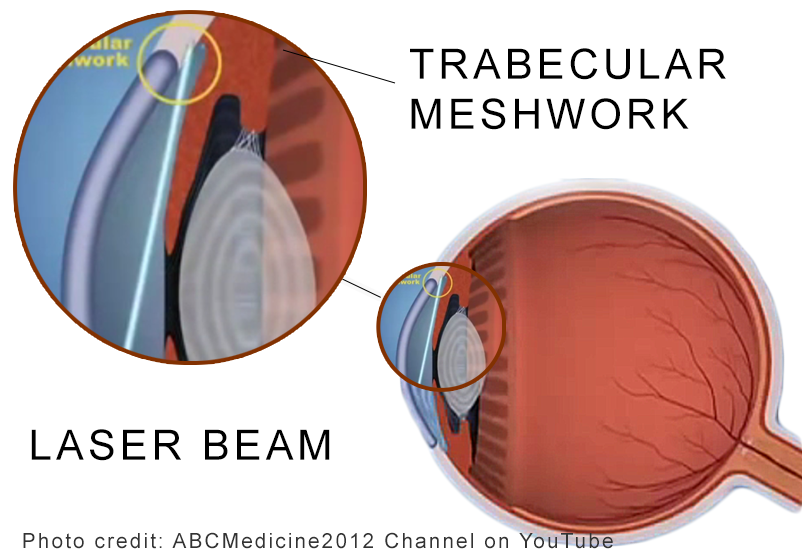Introduction To Laser Trabeculoplasty
In most open angle glaucomas the aqueous fluid is unable to pass through the Trabecular Meshwork (drainage grate inside the eye) as easily as it should.[1] Partly due to this knowledge, most surgical treatments of glaucoma have focused on improving passage of fluid across this meshwork or simply bypassing the meshwork altogether.
Laser Trabeculoplasty. A Quick History.
Laser trabeculoplasty attempts to improve flow of fluid across the trabecular meshwork by focusing wavelengths of light onto the trabecular meshwork. The concept of using light energy to open up the trabecular meshwork dates back to 1961.[2] Lasers were not yet available for clinical research as they had only been invented the year prior to that. Rather, a xenon-arc photocoagulator was used on the trabecular meshwork of animals resulting in a reduction in intraocular pressure (IOP).
It was not until the early 1970s that lasers were used in an attempt to punch holes through the trabecular meshwork.[3] These microscopic holes, however, closed down with time. Ironically, in 1975 it was reported that application of laser energy in an attempt to coagulate (or melt) the trabecular meshwork could be used to experimentally create glaucoma in monkeys.[4]
In a twist that is typical of scientific discovery, another set of scientists discovered that some of these monkeys ended up with long-term lowering of their IOP.[5] By 1979 what we think of as Laser Trabeculoplasty (LT) was introduced in humans.[6] Essentially, 50-100+ very short laser pulses are used to gently irradiate the trabecular meshwork. No holes are created, but for reasons that are not entirely understood, this allows fluid to more easily leave the eye.[7]
References
[1]Grant WM. Further studies on facility of flow through the trabecular meshwork. AMA Arch Ophthalmol. 1958;60(4 Part 1):523-33.
Grant WM. Experimental aqueous perfusion in enucleated human eyes. Arch Ophthalmol. 1963;69:783-801.
[2] Zweng HC, flocks M. Experimental photocoagulation of the anterior chamber angle. A preliminary report. Am J Ophthalmol. 1961;52:163-165.
[3] Worthen DM, Wickham MG. Argon laser trabeculotomy. Trans Am Acad Ophthalmol Otolaryngol. 1974;78(2):OP371-OP375.
[4] Gaasterland D, Kupfer C. Experimental glaucoma in the rhesus monkey. Invest Ophthalmol. 1974;13(6):455-457.
[5] Ticho U, Zauberman H. Argon laser application to the angle structures in the glaucomas. Arch Ophthalmol. 1976;94(1):61-64.
[6] Wise JB, Witter SL. Argon laser therapy for open-angle glaucoma. A pilot study. Arch Ophthalmol. 1979;97(2):319-322.
[7] Pohjanpelto P. Argon laser treatment of the anterior chamber angle for increased intraocular pressure. Acta Ophthalmol. 1981;59(2):211-220.
Lichter PR. Argon laser trabeculoplasty. Trans Am Ophthalmol Soc. 1982;80:288-301.
Brubaker RF, Liesegang TJ. Effect of trabecular photocoagulation on the aqueous humor dynamics of the human eye. Am J Ophthalmol. 1983;96(2):139-147.
Related Articles:
- Types Of Laser Trabeculoplasty
- How Well Does Laser Trabeculoplasty Work?
- Can Laser Trabeculoplasty (LT) Be Repeated?
- Who Should Consider Glaucoma Treatments Other Than Laser Trabeculoplasty (LT)?
- How To Choose Which Type Of Laser Trabeculoplasty To Have
- What Are The Risks Of Laser Trabeculoplasty? Who Should Consider LT?
- Titanium + Sapphire: Great for Jewelry & Glaucoma
- Pattern Scanning Laser Trabeculoplasty (PSLT) Treatment for Glaucoma



